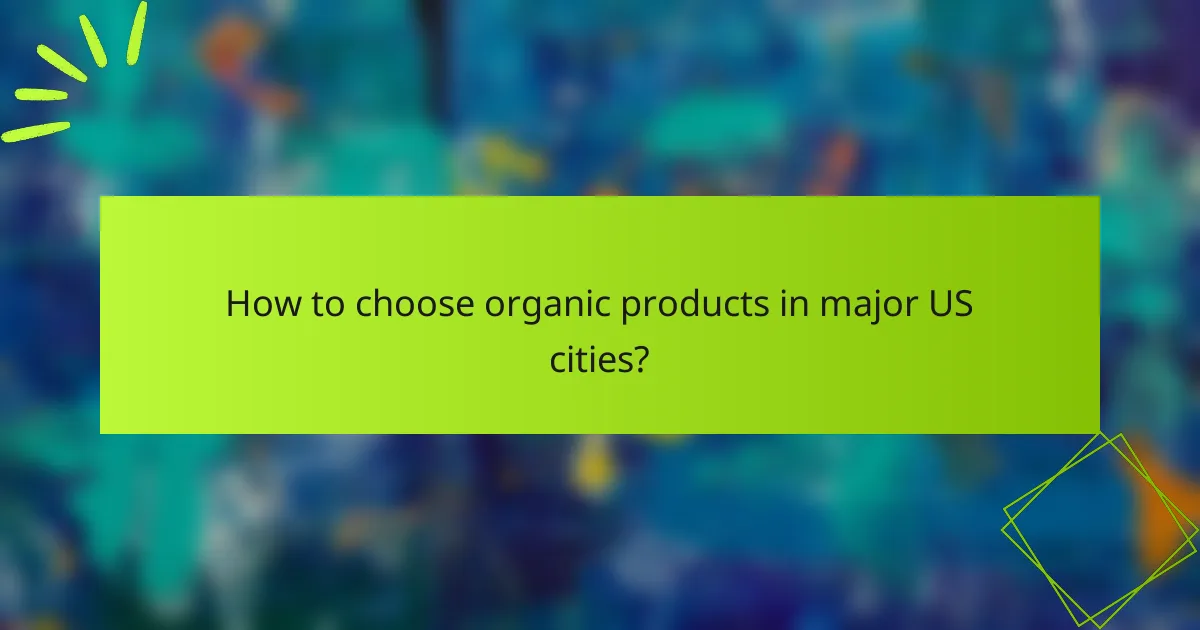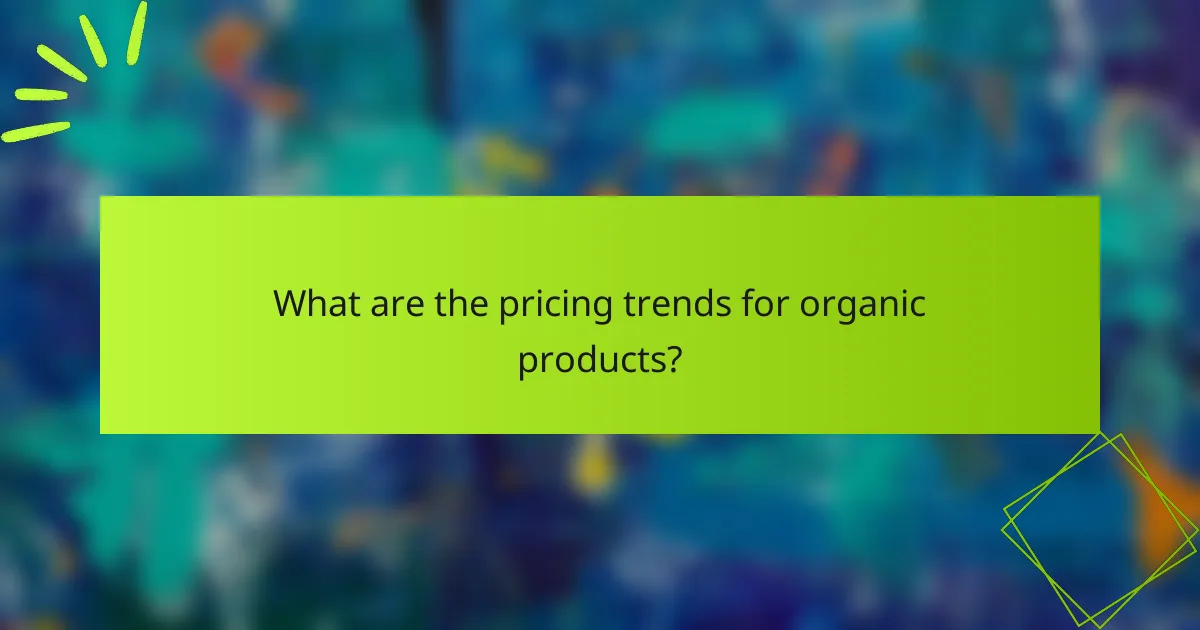Organic products are distinguished by their adherence to specific standards that prioritize natural farming practices and sustainability. Consumers can identify these products by checking labels, certifications, and ingredient lists, ensuring informed purchasing decisions. By choosing organic, shoppers not only enhance their health but also contribute to environmental sustainability and support local economies.

How to identify organic products in retail?
Identifying organic products in retail involves checking labels, certifications, and ingredient lists. Understanding these elements helps consumers make informed choices about their purchases.
Visual inspection of labels
Start by examining product labels for the word “organic” prominently displayed. Look for additional information such as the percentage of organic ingredients, which can range from 70% to 100% for products labeled as organic.
Be cautious of misleading terms like “natural” or “made with organic ingredients,” which may not meet the same standards. Always prioritize products with clear organic labeling for authenticity.
Certification logos to look for
Certification logos are crucial for verifying organic claims. In the U.S., the USDA Organic seal indicates compliance with national organic standards. In Europe, look for the EU Organic logo, which signifies adherence to EU regulations.
Other reputable certifications include those from organizations like Oregon Tilth or the Soil Association. Familiarizing yourself with these logos can help ensure you’re purchasing genuinely organic products.
Understanding ingredient lists
Ingredient lists provide insight into the contents of a product. Organic products should feature organic ingredients listed at the top, reflecting their proportion in the product.
Be wary of synthetic additives or preservatives, which are not permitted in certified organic products. A shorter ingredient list often indicates a more natural product, aligning with organic principles.
Common organic product categories
Organic products span various categories, including fruits, vegetables, dairy, grains, and meat. Common organic items include apples, milk, and chicken, which are often available in most grocery stores.
Many consumers also seek organic packaged goods like snacks and cereals. Familiarizing yourself with these categories can streamline your shopping experience.
Consumer resources for verification
Several resources can assist in verifying organic products. Websites like the USDA Organic Integrity Database allow consumers to check the certification status of brands and products.
Additionally, local organic certification bodies often provide lists of certified producers. Engaging with these resources can enhance your confidence in purchasing organic goods.

What are the standards for organic products?
Organic products must meet specific standards that vary by region but generally emphasize natural farming practices, sustainability, and the absence of synthetic chemicals. These standards ensure that consumers receive products that are grown and processed according to strict guidelines.
USDA Organic certification requirements
The USDA Organic certification requires that products be grown without synthetic fertilizers, pesticides, or genetically modified organisms (GMOs). To achieve this certification, farmers must adhere to a three-year transition period where the land is free from prohibited substances.
Additionally, products must be processed without artificial preservatives or colors. The USDA also mandates that at least 95% of the ingredients in a product must be organic to carry the “USDA Organic” label.
EU Organic standards overview
In the European Union, organic standards are governed by regulations that focus on environmental sustainability and animal welfare. Similar to USDA standards, EU regulations prohibit the use of synthetic chemicals and GMOs in organic farming.
EU organic products must also adhere to strict labeling requirements, ensuring that at least 95% of the ingredients are organic. Furthermore, the EU emphasizes the importance of biodiversity and soil health in organic farming practices.
Differences between organic and non-organic labels
Organic labels signify that products are produced under strict regulations that limit the use of synthetic substances, while non-organic products may contain these chemicals. For example, non-organic fruits and vegetables can be treated with pesticides and fertilizers that are not allowed in organic farming.
Consumers should look for certification labels, such as USDA Organic or EU Organic, to ensure they are purchasing products that meet organic standards. Understanding these differences helps consumers make informed choices about their food and its environmental impact.

What are the benefits of choosing organic products?
Choosing organic products offers numerous advantages, including improved health, environmental sustainability, and support for local economies. These benefits stem from organic farming practices that prioritize natural methods over synthetic inputs.
Health benefits of organic foods
Organic foods are often fresher and free from harmful pesticides and chemicals, which can lead to better health outcomes. Many consumers report fewer allergic reactions and digestive issues when consuming organic products.
Additionally, organic foods may contain higher levels of certain nutrients, such as antioxidants, due to the natural farming methods used. This can contribute to overall well-being and may reduce the risk of chronic diseases.
Environmental impact of organic farming
Organic farming practices promote biodiversity and reduce pollution by avoiding synthetic fertilizers and pesticides. This leads to healthier soil and ecosystems, which are essential for sustainable agriculture.
Furthermore, organic farms typically use crop rotation and other techniques that enhance soil fertility and reduce erosion. These practices help mitigate climate change by sequestering carbon in the soil.
Support for local economies
Buying organic products often means supporting local farmers and businesses, which can strengthen community ties and boost the local economy. Organic farms tend to be smaller and more community-oriented, providing fresh produce directly to consumers.
Investing in local organic agriculture can create jobs and promote sustainable practices, benefiting both the environment and the economy. Consumers can make a positive impact by choosing to shop at local farmers’ markets or organic co-ops.

How to choose organic products in major US cities?
Choosing organic products in major US cities involves understanding certification labels, knowing where to shop, and being aware of local offerings. Look for USDA Organic labels, which ensure products meet strict federal standards for organic farming and processing.
Best organic grocery stores in New York City
New York City boasts several excellent organic grocery stores that cater to diverse needs. Whole Foods Market is a popular choice, offering a wide range of organic products, from fresh produce to packaged goods. Another notable option is Fairway Market, known for its extensive selection of organic items at competitive prices.
For a more localized experience, consider visiting Union Market, which focuses on sourcing organic products from local farms and suppliers. These stores not only provide quality organic options but also often host events and tastings to engage the community.
Top organic markets in Los Angeles
Los Angeles features a vibrant scene for organic markets, with many options available across the city. Erewhon Market is a standout, known for its premium organic offerings and trendy atmosphere. Another great choice is Sprouts Farmers Market, which combines affordability with a solid selection of organic products.
Additionally, the Los Angeles Farmers Market at 3rd and Fairfax offers a variety of organic vendors, allowing shoppers to buy directly from local producers. This market is an excellent place to find fresh, seasonal organic produce and artisanal products.
Local farmers’ markets for organic produce
Farmers’ markets are a fantastic way to access organic produce directly from local growers. Many cities have weekly markets where farmers sell their organic fruits, vegetables, and other products. In New York City, the Union Square Greenmarket is one of the largest and most popular, featuring numerous vendors who specialize in organic offerings.
In Los Angeles, the Hollywood Farmers Market is a must-visit, with a strong emphasis on organic produce and sustainable practices. Shopping at these markets not only supports local agriculture but also provides an opportunity to learn about the origins of your food and seasonal availability.

What are the pricing trends for organic products?
Pricing trends for organic products indicate that they typically cost more than conventional items. This premium reflects the higher production standards, certification processes, and often smaller scale of organic farming.
Average price comparison with conventional products
On average, organic products can be priced 20-50% higher than their conventional counterparts. For example, organic fruits and vegetables often command a significant markup due to the costs associated with organic farming practices and certifications.
In some cases, organic dairy and meat products may see even larger price differences, sometimes exceeding 50% more than conventional options. Consumers should consider these factors when budgeting for groceries.
Factors influencing organic product pricing
Several factors contribute to the pricing of organic products, including production costs, supply chain logistics, and market demand. Organic farming often requires more labor-intensive practices and stricter regulations, which can drive up costs.
Additionally, the availability of organic products can fluctuate based on seasonality and regional farming capabilities, impacting prices. Consumers should be aware that organic certification processes also add to the overall cost.
Seasonal price fluctuations
Organic product prices can vary significantly with the seasons. For instance, organic produce is generally less expensive during peak harvest times when supply is abundant. Conversely, prices may rise during off-seasons when organic items are less available.
Shoppers can take advantage of lower prices by purchasing organic fruits and vegetables in season or considering frozen organic options, which can offer better value year-round. Keeping an eye on local farmers’ markets can also yield seasonal deals on organic products.

What are the emerging trends in organic retail?
Emerging trends in organic retail include increased consumer demand for transparency, sustainability, and convenience. Retailers are adapting by offering more organic options, enhancing product labeling, and utilizing technology to streamline shopping experiences.
Increased consumer demand for transparency
Consumers are increasingly seeking detailed information about the origins and production methods of organic products. This trend drives retailers to provide clearer labeling and traceability, allowing shoppers to make informed choices about the food they purchase.
For example, many brands now include QR codes on packaging that link to information about farming practices, ingredient sourcing, and certifications. This transparency builds trust and encourages loyalty among consumers who prioritize ethical consumption.
Sustainability in packaging and sourcing
Sustainability is becoming a key factor in organic retail, with both consumers and retailers prioritizing eco-friendly practices. This includes using biodegradable or recyclable packaging and sourcing ingredients from sustainable farms.
Retailers are increasingly collaborating with local farmers and suppliers to reduce carbon footprints and support community economies. This not only appeals to environmentally conscious consumers but also helps differentiate brands in a competitive market.
Technological advancements in shopping experiences
Technology is transforming organic retail by enhancing the shopping experience through online platforms and mobile apps. Consumers can now easily access a wider range of organic products, compare prices, and read reviews from the comfort of their homes.
Additionally, many retailers are adopting artificial intelligence and data analytics to personalize shopping experiences, recommend products, and manage inventory more efficiently. These advancements help meet the growing demand for convenience while maintaining product quality.
